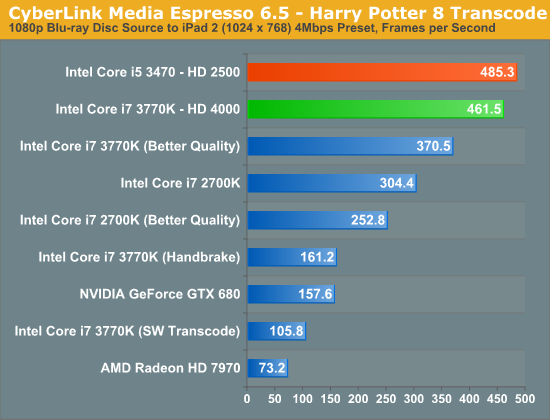Intel Core i5 3470 Review: HD 2500 Graphics Tested
by Anand Lal Shimpi on May 31, 2012 12:00 AM EST- Posted in
- CPUs
- Intel
- Ivy Bridge
- GPUs
Intel's HD 2500 & Quick Sync Performance
What makes the 3470 particularly interesting to look at is the fact that it features Intel's HD 2500 processor graphics. The main difference between the 2500 and 4000 is the number of compute units on-die:
| Intel Processor Graphics Comparison | ||||
| Intel HD 2500 | Intel HD 4000 | |||
| EUs | 6 | 16 | ||
| Base Clock | 650MHz | 650MHz | ||
| Max Turbo | 1150MHz | 1150MHz | ||
At 6 EUs, Intel's HD 2500 has the same number of compute resources as the previous generation HD 2000. In fact, Intel claims that performance should be around 10 - 20% faster than HD 2000 in 3D games. Given that Intel's HD 4000 is getting close to the minimum level of 3D performance we'd like to see from Intel, chances are the 2500 will not impress. We'll get to quantifying that shortly, but the good news is Quick Sync performance is retained:

The HD 2500 does a little better than our HD 4000 here, but that's just normal run to run variance. Quick Sync does rely heavily on the EU array for transcode work, but it looks like the workload itself isn't heavy enough to distinguish between the 6 EU HD 2500 and the 16 EU HD 4000. If your only need for Intel's processor graphics is for transcode work, the HD 2500 appears indistinguishable from the HD 4000.
The bad news is I can't say the same about its 3D graphics performance.










67 Comments
View All Comments
Ryan Smith - Thursday, May 31, 2012 - link
Your completely right. We were in a rush and copied that passage from our original IVB review, which is no longer applicable.SteelCity1981 - Thursday, May 31, 2012 - link
Intel could have at least called it a 3500 and slap 2 more EU's onto it.fic2 - Thursday, May 31, 2012 - link
Agreed. I don't understand why Intel basically stood pat on the low end HD.But then again like everyone else I never understood why the HD3000 was only in the K series and maybe 5% of K series users don't have discreet gpu so the HD3000 isn't being used.
CeriseCogburn - Monday, June 11, 2012 - link
Good point. Lucid logic tried to fix that some, and did a decent job, and don't forget quick sync, plus now with zero core amd cards, and even low idle power 670's and 680's, leaving on SB K chip hd3000 cores looks even better - who isn't trained in low power if they have a video card, after all it's almost all people rail about for the last 4 years.So if any of that constant clamor for a few watts power savings has any teeth whatsoever, every person with an amd card before this last gen will be using the SB HD3000 and then switching on the fly to gaming with lucid logic.
n9ntje - Thursday, May 31, 2012 - link
So this must be a midrange desktop chip? Horrendous performance on the graphics side from Intel again.Very curious how AMD's trinity dekstop will perform, at the same pricerange it will be obvious it will obliterate Intel's offerings on the graphics side. What's more impressive AMD is still on 32nm..
7Enigma - Thursday, May 31, 2012 - link
For me this IS the perfect chip. No use for the GPU so cheaper = better. I would need a K model though for OC'ing potential, but I'm glad to see that if I can't have my CPU-only (no GPU) chip, at least I can have a hacked down version that is more in line with a traditional CPU.silverblue - Thursday, May 31, 2012 - link
What Intel should really be doing here is offering the 4000 on all i3s and some i5s to offset the reduced CPU performance. If you want to give AMD something to think about, HD 4000 on an Ivy Bridge dual core is very much the right way of going about it.CeriseCogburn - Friday, June 1, 2012 - link
Then Intel has a lame trinity level cpu next to a losing gpu.I think Intel will stick with it's own implementations, don't expect to be hired as future product manager.
ShieTar - Thursday, May 31, 2012 - link
Interestingly enough, Intel will also happily sell you what is basically the same chip, without any GPU, 100 MHz slower but with 2MB extra L3-Cache for the same price. They call that offer Xeon E3-1220V2. And it is 69W TDP, not 77W as the i5-3470.Who knows, the bigger Cache might even make it the better CPU for a not-overclocking gamer. If normal boards support it.
Pazz - Thursday, May 31, 2012 - link
Anand,Following on from your closing statement with regards to the HD 4000 being the miniumum, will you be doing a review of the 3570K? Surely with this model being the lowest budget Ivy HD4000 chip, it'll be a fairly popular option for many system builders and OEM's.